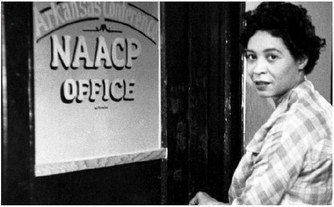Daisy Bates — A Voice for Peace and Hope

Daisy Bates — A Voice for Peace and Hope
Perhaps a hopeful theme for this months’s History Minute with the story of Daisy Bates.
The world becomes a better place when people are willing to take a stand for others. In one of the most contentious ages in Arkansas History, Daisy Bates was a voice for peace and justice during the civil rights struggles. Her work helped show that the past does not have to define the future.
Some details of her early life are not entirely clear. She is believed to have been born Daisy Lee Gatson sometime around 1913 in eastern Union County. Many relatives still live in the area. Her mother was murdered while she was still a young child. The suspects, three white men, were never tried or convicted. Her family disintegrated as a result, and she was taken in by foster parents around the age of seven. Her foster father worked in a mill in Huttig in southeast Union County. Her education in the segregated schools of the day was sporadic.
She met L. C. Bates in the late 1920s and moved to Memphis. The two moved to Little Rock in 1941 and started the Arkansas State Press, a newspaper devoted to civil rights. The two married in 1942 and worked to make the paper a success. They became prominent in the Little Rock community and were heavily involved in civil rights organizations.
Daisy Bates had suffered much in her life because of hate. She did not call for retribution or hate in return. She called for justice and understanding for all. Perhaps her greatest test came in 1956 as Little Rock schools slowly prepared to desegregate. Bates worked as a mediator between the school board and the families of nine African-American children preparing to attend the then all-white Central High School. At the beginning of the 1957 school year, the 'Little Rock Nine' faced death threats and attempts by Gov. Orval Faubus to defy the courts and prevent them from attending school. While civil rights attorneys fought Faubus in court and Bates and her husband faced their own threats for their roles, she continued to counsel the families of the students and work to find a peaceful solution to the crisis.
The nine children were eventually able to attend Central High with federal protection, and the way was paved for more minority children to begin attending Little Rock schools as well. The Associated Press named her Woman of the Year in Education in 1957. However, white supremacists had threatened so many advertisers with boycotts that the Arkansas State Press steadily lost money and closed in 1959.
She continued to speak out on civil rights causes, writing a memoir of her experiences with the desegregation crisis in 1960, The Long Shadow of Little Rock. In 1963, she spoke at the Lincoln Memorial as part of Martin Luther King's March on Washington. In the 1970s, she worked for the City of Mitchellville in eastern Arkansas as director of the Economic Development Agency, helping secure community development and education grants for the community.
Though her husband died in 1980, Bates spent her last years continuing to work for civil rights causes in Little Rock and urging peace and understanding among the races. She died in 1999, revered by the community, both black and white.
The City of Little Rock later honored her by naming a street near Philander Smith College for her and her husband. An elementary school in southern Pulaski County just off Interstate 530 was also named for her.
And in part because of the work of men and women like L. C. and Daisy Bates, Arkansas has started to move away from its violent racial past and embrace a future of possibilities and understanding for children of all races.
[Editor’s Note: The first collection of Dr. Kenneth Bridges’ History Minute columns, “In An Arkansas Minute,” is now available on Amazon.com]
Dr. Kenneth Bridges teaches history and geography at South Arkansas Community College. He is co- editor of the “ South Arkansas Historical Journal” and author of numerous history articles and books.
“History Minute” By Dr.
Ken Bridges




Share